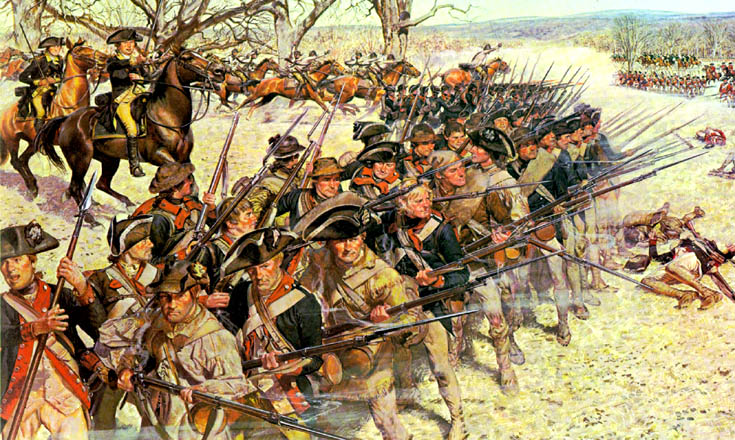
The American War of Independence – Playing the Period
29th January 2000, Comments Off
Teaching the Colonials a lesson…
American War of Independence in the Journal

This is probably my oldest 25mm period, and until recently it showed. Being the first “proper” 25mm army I painted (and my painting standard was a lot lower than it is now) then they all look a little .. er .. basic! Therefore I’m replacing and repainting almost all of them before they see the light of day again. My figures have also suffered from being kicked around, rebased and generally abused over the years, and my two armies were in desperate need of refurbishment! The other problem is that since I first bought into the period so many new and better figures have come out that I couldn’t help buying replacements. All I needed to do was to finish painting my AWI lead mountain! The whole project kept being put on the back burner, as other periods took priority, but eventually by the summer of 2010 my armies were finally ready to take the field.

Actually, most of the early stuff landed up going to a “Bring n’ Buy”, as I’ve been convinced that the British (and their Loyalist supporters) opted for round hats and shortened jackets pretty early on in the conflict – by the Summer of ’76 at the latest. This means that unless I plan to refight Bunker Hill or Lexington, then my Old Glory or Front Rank figures in their tricorne hats aren’t much use. That said, whatever the purist say, I’ll be damned if my British Grenadiers will be trading in their bearskins for slouch hats. There are limits, old chap!
While my original army was a mixture of Old Glory and Dixons, most of my figures now come from the ranges of Perry Miniatures and Foundry – with a few of my older Dixon figures mixed in where I can. The Perry twins produce some incredible figures, and their American War of Independence range really has to be seen to be believed! I’ve now started the business of painting my way through my AWI lead mountain – the first units of which are the colonial militia at the top of the page. After all, they’re the boys you’ll need a lot of – even if they don’t hang around the table too long. The great flags are from GMB Designs. Since then I’ve added guns, units of riflemen, and two cavalry units (3rd Cont. Dragoons and Lee’s Legion). I’m also added a brigade of four Continental line regiments – Maryland and Virginia regiments.

In the past I’ve used Patriots & Loyalists, which have always produced enjoyable games… especially when Washington or Cornwallis get killed trying to save the day. However, I’ve also used British Grenadier. They’re the AWI variant of General de Brigade, Dave Brown’s Napoleonic set. After all, it makes sense if I use the same basic rules system for four of my five Horse & Musket periods. They were heavily influenced by another good set – Andy Callan two-page set Loose Files & Scramble, which can still be found on the Web as a free download. However, as British Grenadier have a few quirky elements such as Disruption Points, we also tried using Die Kriegskunst (our Seven Years War variant), which works much the same but produces a slightly quicker game. However, British Grenadier’s system really captured the feel of the period, and their 1:20 figure ratio worked well, so we’ve stuck by them.
More recently, we’ve tried a game with Black Powder, and really liked the rules – at least for other periods. Somehow they struggle to capture the variable troop qualities of this war, and the British tend to get a hiding. I can see this set becoming our new rules of choice for big Napoleonic or Seven Years War games, but not really for the War of Independence.
Watch this space for updates as the project continues. My next task is to expand the British, and add more Continental regulars, both geared up for the fighting around Philadelphia. So far the only games we’ve played have involved the Southern Campaign, so it would be nice to expand our gaming repertoire.

